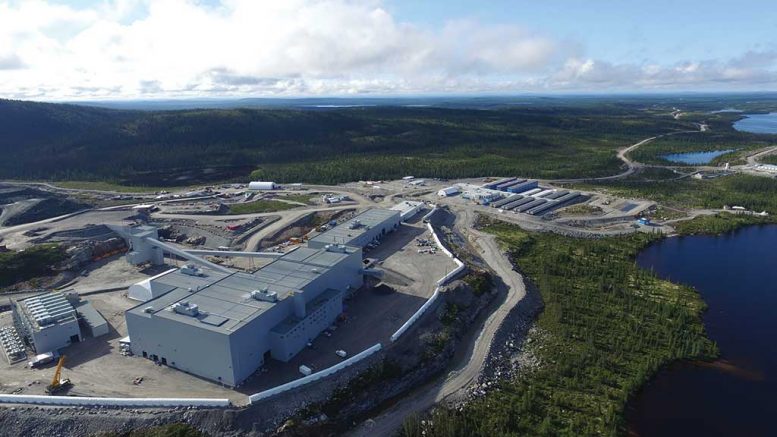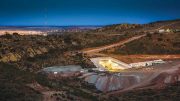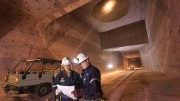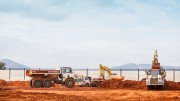Canada is the world’s third-largest diamond producer in terms of volume in carats and value, according to production estimates of New York-based diamond analyst Paul Zimnisky. The Northern Miner has compiled the top-10 Canadian-headquartered diamond companies by market capitalization, as of June 29, 2018.

Lucara Diamond’s Karowe Mine in Botswana. Credit: Lucara Diamond
1. Lucara Diamond
Market cap: $799 million
Lucara Diamond (TSX: LUC) owns the Karowe diamond mine in Botswana, which has been in production since 2012. The mine has produced many exceptional large, Type IIa diamonds (including the 1,109-carat Lesedi la Rona stone — the second-largest diamond in history, and the 813-carat Constellation diamond, which sold for US$63.1 million). Karowe could produce 270,000 to 290,000 carats of diamonds in 2018 and the open-pit operation has enough ore to support mining until 2026.
The mine has underground potential, as well. A positive preliminary economic assessment in November 2017 estimated that an underground component would extend Karowe’s mine life by 10 years and produce another 2.72 million carats at a US$195-million, pre-production capital cost. Earlier this year, Lucara acquired Clara Diamond Solutions, a technology company working to bring its proprietary secure digital sales platform for diamonds to market. The platform uses computing algorithms to match rough diamond production to buyers who want stones with the same characteristics.

Mining at the Gahcho Kue diamond mine. Credit: Mountain Province Diamonds
2. Mountain Province Diamonds
Market cap: $500 million
Mountain Province Diamonds (TSX: MPVD; NASDAQ: MPVD) is a 49% participant with De Beers Canada in the Gahcho Kué diamond mine in the Northwest Territories. Gahcho Kué is the world’s largest new diamond mine, consisting of a cluster of four diamond-bearing kimberlites, three of which are being developed and mined under an initial 12-year mine plan.
In April, Mountain Province Diamonds completed its business combination with Kennady Diamonds. Kennady Diamonds owned 100% of the Kennady North project, which is next to Gahcho Kué. Kennady North’s Kelvin kimberlite has an indicated resource of 13.62 million carats of diamonds contained in 8.50 million tonnes of kimberlite, with a grade of 1.60 carats per tonne. The Faraday kimberlites have an inferred resource of 5.02 million carats in 3.27 million tonnes of kimberlite, with a grade of 1.54 carats per tonne.

The Renard mine, in Quebec. Credit: Stornoway Diamond.
3. Stornoway Diamond
Market cap: $351 million
Stornoway Diamond’s (TSX: SWY; US-OTC: SWYDF) wholly owned Renard mine is Quebec’s first diamond mine and Canada’s sixth. The mine, 350 km north of Chibougamau in the province’s James Bay region, started commercial production in January 2017 and is the lowest-cost diamond mine in Canada.
Renard could make an average of 1.8 million carats per year over the first decade of mining. In the first half of this year, ore production transitioned from open pit to underground. In January, Stornoway said it expects to produce 1.6 million carats in 2018 from processing 2.5 million tonnes of ore at an average grade of 65 carats per tonne.

Reverse-circulation drilling at the CH-7 kimberlite at Peregrine Diamonds’ and BHP Billiton’s Chidliak project, in Nunavut. Credit: Peregrine Diamonds.
4. Peregrine Diamonds
Market cap: $75 million
Peregrine Diamonds (TSX: PGD; US-OTC: PGDIF) is focused on its wholly owned Chidliak project on Baffin Island in Nunavut, 120 km from Iqaluit. Peregrine first found kimberlite on the project in 2008, with the surface discoveries of the 1, 2 and 3 kimberlite pipes. Since then, it has identified a total of 74 kimberlites at Chidliak, 45 of which are diamondiferous. Eight of the 74 kimberlites have been identified as potentially economic through drilling and microdiamond analysis.
In May, Peregrine updated the PEA on the project’s 6 and 7 kimberlites. The study outlines a 13-year mine life, a $679-million after-tax net present value at a 7.5% discount rate and a 31.1% after-tax internal rate of return. Pre-production capital requirements of $455 million, including $95 million for an access road from Iqaluit and $55 million contingency, could be paid back, after-tax, in just over two years.
The resources at both 6 and 7 remain open at depth. Kimberlite 6 has an inferred resource of 17.96 million carats in 7.46 million tonnes at 2.41 carats per tonne (extending from surface to a depth of 525 metres below surface). Kimberlite 7 has inferred resources of 4.23 million carats in 4.99 million tonnes at 0.85 carat per tonne (extending from surface to a 240-metre depth).
Peregrine also owns the Nanuq and Nanuq North properties in Nunavut, which host four diamond-bearing kimberlites. The combined, 1,580 sq. km Nanuq and Nanuq North properties are 225 km east–northeast of Baker Lake.
Elsewhere in Canada, Peregrine controls the 84.94 sq. km Lac de Gras project in the Northwest Territories, 27 km from the Diavik mine. The 0.09 sq. km, 72.1%-owned 27 kimberlite has an indicated resource of 18.2 million diamond carats in 19.5 million tonnes kimberlite at a grade of 0.94 carat per tonne, and is open at depth.
Outside Canada, Peregrine has a 1% gross overriding royalty on revenue from the sale of production from certain mineral properties in Botswana.

The Star-Orion South diamond project, in Saskatchewan. Credit: Star Diamond.
5. Star Diamond
Market cap: $65 million
Star Diamond (TSX: DIAM), which changed its name from Shore Gold earlier this year, owns the Star-Orion South diamond project in the Fort à la Corne forest in central Saskatchewan, 60 km east of Prince Albert. The company completed a PEA in April 2018 estimating that 66 million carats of diamonds could be recovered from an open pit over a 34-year mine life with a net present value, at a 7% discount rate, of $2.02 billion after tax, and 19% post-tax internal rate of return. The study estimates pre-production capital costs of $1.41 billion with a total capital cost of $1.87 billion, and an initial, after-tax capital cost payback period of 3.4 years.
The Star and Orion South kimberlites have an indicated resource of 393 million tonnes containing 55.4 million carats of diamonds at a weighted average price of US$210 per carat. Inferred resources add 11.5 million carats.
Star Diamond says the project contains a significant proportion of high-value, Type IIa diamonds, which contain no nitrogen or boron impurities; are usually top white or brown (and can also be pink); and account for less than 1.3% of the world’s annual diamond production.
Newmont Mining owns 19.9% of the company. Rio Tinto Exploration Canada has an option to earn a 60% interest in the Fort à la Corne properties, including the Star-Orion South diamond project.

Dominion Diamond’s Ekati mine in the Northwest Territories. Credit: Dominion Diamond.
6. Archon Minerals
Market cap: $55 million
Archon Minerals (TSXV: ACS) has a gross production royalty equal to 2.3% of the gross value of diamonds produced from the Buffer zone at Dominion Diamond’s Ekati mine. (The company converted its working interest in the Buffer zone to a royalty in June 2017.) The Buffer zone contains the Lynx pipe, which started commercial open-pit production last year, and the Jay pipe. Archon also owns 100% of the 200,000 acres of mineral leases that were formerly part of the western Buffer Zone, as well as interests in other diamond properties in the area. Archon Minerals is headed by mine finder Stewart Blusson, who, with Chuck Fipke, found Canada’s first economic diamond deposit in the Northwest Territories near Lac de Gras, now known as the Ekati mine.

De Beers’ Orapa mine in Botswana. Credit: De Beers.
7. Tsodilo Resources
Market cap: $26.754 million
Tsodilo Resources (TSXV: TSD) is exploring its 16 kimberlite project in Botswana’s Orapa kimberlite field. The 16 is 0.06 sq. km at surface and is known to contain rare and valuable Type IIa diamonds. In mid-July the company gave results from an independent evaluation of the first diamond parcel from 16. A parcel consisting of 224 diamonds totalling 34.25 carats of commercial size (above 1 mm) was valued at US$197.65 per carat. The parcel was dominated by white, gem-quality diamonds, many of which were G-colour or higher. Tsodilo noted that it was a relatively small sample. It also said that the proportion of low-quality diamonds was very low compared to other Botswana kimberlites.
In January the company installed a Polus-M sorter at its secure facility in Maun, Botswana. The machine is designed to treat dry diamond concentrate with grain size -8+6, -6+3 and -3+1 mm in the field to carry out geological exploration of diamond deposits.
8. Lithoquest Diamonds
Market cap: $23 million
Lithoquest Diamonds (TSXV: LDI) is exploring for diamonds on its 100% owned North Kimberley diamond project in northwestern Australia. The project is situated in the northern portion of the Kimberley Plateau, 225 km from Kununurra in New South Wales. The company is in the early stages of exploration and has identified six kimberlite pipes and eight kimberlite dikes on its 1,000 sq. km project area.
In April, the company recovered three micro diamonds from a 10 kg sample of rock outcrop at its Target 702. Lithoquest is fully funded for its drill program this year. There are no underlying royalties on the property. The company listed on the TSX Venture Exchange on Nov. 29, 2017. Australia’s Kimberley region hosts two of the country’s three economic diamond discoveries (Argyle and Ellendale).

Past trial mining work at Diamcor’s Krone-Endora project. Photo by Diamcor Mining.
9. Diamcor Mining
Market cap: $21 million
Diamcor Mining (TSXV: DMI; US-OTC: DMIFF) owns the Krone-Endora at Venetia project in South Africa, which it acquired from De Beers Consolidated Mines Ltd. in February 2011. Krone 104 and Endora 66 are next to De Beers’ flagship Venetia Diamond mine in South Africa. Diamcor’s near-surface deposits come from the shift and erosion of material from the higher grounds of the nearby Venetia kimberlites.
The deposits on Krone-Endora occur in two layers with a maximum 15-metre depth from surface to bedrock, which the company says will allow for a low-cost mining operation. Diamcor has a strategic alliance with Tiffany & Co. Canada, a subsidiary of New York-based Tiffany & Co., to buy up to 100% of the future production of rough diamonds from Krone-Endora at Venetia. Tiffany & Co. Canada is also providing financing to advance the project.
10. Arctic Star Exploration
Market cap: $14 million
Arctic Star Exploration (TSXV: ADD; US-OTC: ASDZF) owns 100% of its flagship Timantti diamond project in Finland, near the township of Kuusamo, 550 km southwest of the operating Grib diamond mine in Russia. Timantti was discovered after finding a diamond-bearing kimberlite at surface. Since then, Arctic has found four kimberlite occurrences: White Wolf, Black Wolf, Grey Wolf and the Vasa Dyke swarm. Earlier this month, the company reported a total of 1,032 diamonds from 409.3 kg of White Wolf kimberlite.
In addition to Finland, Arctic Star controls diamond exploration properties in Canada: Diagras and Redemption in the Northwest Territories and Stein in Nunavut. Diagras is a joint venture with Margaret Lake Diamonds, which has earned a 60% stake. Diagras is in the northeastern part of the Lac de Gras kimberlite field, 22 km northeast of the Diavik diamond mine and 36 km east of the Ekati diamond mine. The company says it has verified through research and compilation that the property hosts more than a dozen kimberlites, most of which it says are diamondiferous.
The Redemption project is made up of two properties (T-Rex and Triceratops) in the Slave craton near the Lac de Gras kimberlite field. The Redemption properties are also close to Ekati and Diavik, and $20 million has been spent following indicator mineral trains that contain G10 chemistry and diamonds.
Stein, 85 km northwest of Taloyoak, has six drill-ready targets with just 3 metres of overburden. The property consists of four adjoining prospecting permits covering an area of 1,056 sq. km on the Boothia Peninsula.






Be the first to comment on "Top 10 Canadian-based diamond companies"